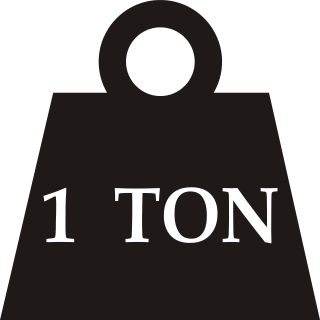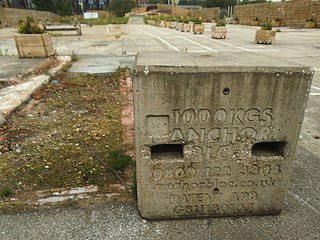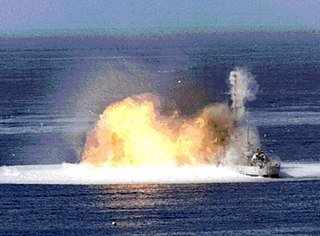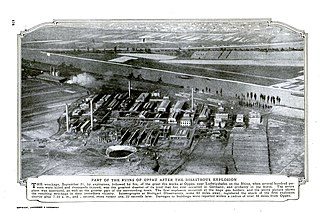Related Research Articles

RDX (abbreviation of "Research Department eXplosive") or hexogen, among other names, is an organic compound with the formula (O2N2CH2)3. It is a white solid without smell or taste, widely used as an explosive. Chemically, it is classified as a nitroamine alongside HMX, which is a more energetic explosive than TNT. It was used widely in World War II and remains common in military applications.

Dynamite is an explosive made of nitroglycerin, sorbents and stabilizers. It was invented by the Swedish chemist and engineer Alfred Nobel in Geesthacht, Northern Germany and patented in 1867. It rapidly gained wide-scale use as a more powerful alternative to black powder.

An explosive is a reactive substance that contains a great amount of potential energy that can produce an explosion if released suddenly, usually accompanied by the production of light, heat, sound, and pressure. An explosive charge is a measured quantity of explosive material, which may either be composed solely of one ingredient or be a mixture containing at least two substances.

The ton is a unit of measure. It has a long history and has acquired a number of meanings and uses over the years. It is used principally as a unit of weight. Its original use as a measurement of volume has continued in the capacity of cargo ships and in terms such as the freight ton. Recent specialized uses include the ton as a measure of energy and for truck classification. It is also a colloquial term, "ton" is the heaviest unit of weight typically used in colloquial speech. It is also used informally to mean a large amount of something, material or not.

Trinitrotoluene, more commonly known as TNT, more specifically 2,4,6-trinitrotoluene, and by its preferred IUPAC name 2-methyl-1,3,5-trinitrobenzene, is a chemical compound with the formula C6H2(NO2)3CH3. TNT is occasionally used as a reagent in chemical synthesis, but it is best known as an explosive material with convenient handling properties. The explosive yield of TNT is considered to be the standard comparative convention of bombs and asteroid impacts. In chemistry, TNT is used to generate charge transfer salts.

The tonne is a metric unit of mass equal to 1,000 kilograms. It is also referred to as a metric ton to distinguish it from the non-metric units of short ton (US), and long ton (UK). It is equivalent to approximately 2,204.6 pounds, 1.102 short tons (US), and 0.984 long tons (UK). The official SI unit is the megagram, a less common way to express the same mass.

A thermobaric weapon, also called an aerosol bomb, a vacuum bomb or a fuel air explosive (FAE), is a type of explosive that uses oxygen from the surrounding air to generate a high-temperature explosion. The fuel–air explosive is one of the best-known types of thermobaric weapons.
The mole, symbol mol, is the SI base unit of amount of substance. The quantity amount of substance is a measure of how many elementary entities of a given substance are in an object or sample. Depending on what the substance is, an elementary entity may be an atom, a molecule, an ion, an ion pair, or a subatomic particle such as an electron. For example, if beaker A contains 10 moles of water and beaker B contains 10 moles of mercury, they contain equal amounts of substance and beaker B contains exactly 1 atom of mercury for each molecule of water in beaker A, despite the two beakers' containing different volumes and very different masses of liquid.
The dalton or unified atomic mass unit is a unit of mass widely used in physics and chemistry. It is defined as 1⁄12 of the mass of an unbound neutral atom of carbon-12 in its nuclear and electronic ground state and at rest. The atomic mass constant, denoted mu, is defined identically, giving mu = m(12C)/12 = 1 Da.

Ammonium nitrate is a chemical compound with the chemical formula NH4NO3. It is a white crystalline solid consisting of ions of ammonium and nitrate. It is highly soluble in water and hygroscopic as a solid, although it does not form hydrates. It is predominantly used in agriculture as a high-nitrogen fertilizer. Global production was estimated at 21.6 million tonnes in 2017.

A projectile is an object that is propelled by the application of an external force and then moves freely under the influence of gravity and air resistance. Although any objects in motion through space are projectiles, they are commonly found in warfare and sports.

Amatol is a highly explosive material made from a mixture of TNT and ammonium nitrate. The British name originates from the words ammonium and toluene. Similar mixtures were known as Schneiderite in France. Amatol was used extensively during World War I and World War II, typically as an explosive in military weapons such as aircraft bombs, shells, depth charges, and naval mines. It was eventually replaced with alternative explosives such as Composition B, Torpex, and tritonal.

A shell, in a military context, is a projectile whose payload contains an explosive, incendiary, or other chemical filling. Originally it was called a bombshell, but "shell" has come to be unambiguous in a military context. Modern usage sometimes includes large solid kinetic projectiles that is properly termed shot. Solid shot may contain a pyrotechnic compound if a tracer or spotting charge is used.

2,4-Dinitrophenol (2,4-DNP or simply DNP) is an organic compound with the formula HOC6H3(NO2)2. It is a yellow, crystalline solid that has a sweet, musty odor. It sublimes, is volatile with steam, and is soluble in most organic solvents as well as aqueous alkaline solutions. When in a dry form, it is a high explosive and has an instantaneous explosion hazard. It is a precursor to other chemicals and is biochemically active, uncoupling oxidative phosphorylation from the electron transport chain in cells with mitochondria, by allowing protons to pass from the intermembrane space into the mitochondrial matrix. Oxidative phosphorylation is a highly regulated step in aerobic respiration that is inhibited, among other factors, by normal cellular levels of ATP. Uncoupling it results in chemical energy from diet and energy stores such as triglycerides being wasted as heat with minimal regulation, leading to dangerously high body temperatures that may develop into heatstroke. Its use as a dieting aid has been identified with severe side-effects, including a number of deaths.

2,4-Dinitrotoluene (DNT) or dinitro is an organic compound with the formula C7H6N2O4. This pale yellow crystalline solid is well known as a precursor to trinitrotoluene (TNT) but is mainly produced as a precursor to toluene diisocyanate.

The explosive yield of a nuclear weapon is the amount of energy released when that particular nuclear weapon is detonated, usually expressed as a TNT equivalent (the standardized equivalent mass of trinitrotoluene which, if detonated, would produce the same energy discharge), either in kilotons (kt—thousands of tons of TNT), in megatons (Mt—millions of tons of TNT), or sometimes in terajoules (TJ). An explosive yield of one terajoule is equal to 0.239 kilotonnes of TNT. Because the accuracy of any measurement of the energy released by TNT has always been problematic, the conventional definition is that one kiloton of TNT is held simply to be equivalent to 1012 calories.

The Oppau explosion occurred on September 21, 1921, when approximately 4,500 tonnes of a mixture of ammonium sulfate and ammonium nitrate fertilizer stored in a tower silo exploded at a BASF plant in Oppau, now part of Ludwigshafen, Germany, killing 500–600 people and injuring about 2,000 more.
Explosives trace detectors (ETD) are explosive detection equipment able to detect explosives of small magnitude. The detection is accomplished by sampling non-visible "trace" amounts of particulates. Devices similar to ETDs are also used to detect narcotics. The equipment is used mainly in airports and other vulnerable areas considered susceptible to acts of unlawful interference. Dr. Stephen Lee is credited with inventing the Fido explosives detector while working at the Army Research Laboratory.

TNT equivalent is a convention for expressing energy, typically used to describe the energy released in an explosion. The tonne of TNT is a unit of energy defined by that convention to be 4.184 gigajoules, which is the approximate energy released in the detonation of a metric ton of TNT. In other words, for each gram of TNT exploded, 4.184 kilojoules of energy is released.
References
- ↑ http://www.derbyshire.gov.uk/business/licences/explosives/ www.derbyshire.gov.uk, accessed 5 October 2014
- ↑ Net explosive weight, DOD Dictionary of Military and Associated Terms, accessed 21 March 2008